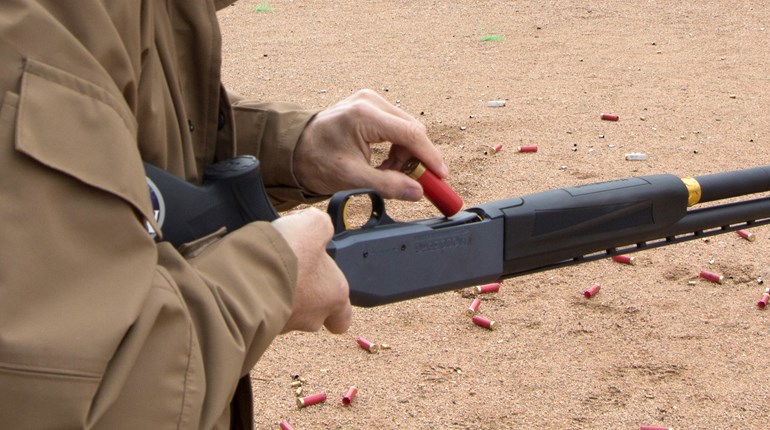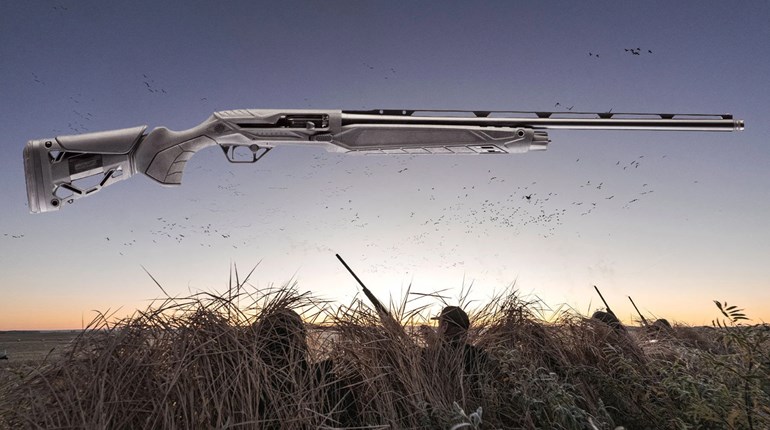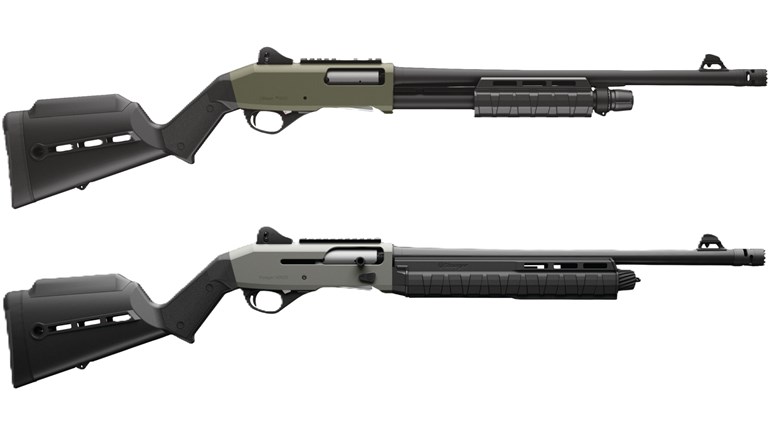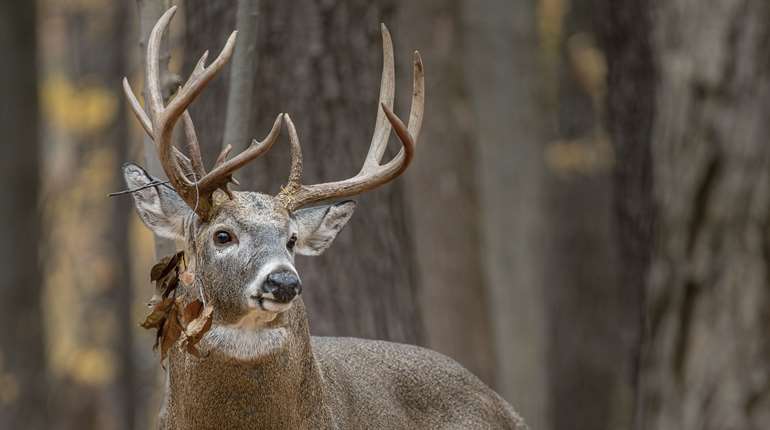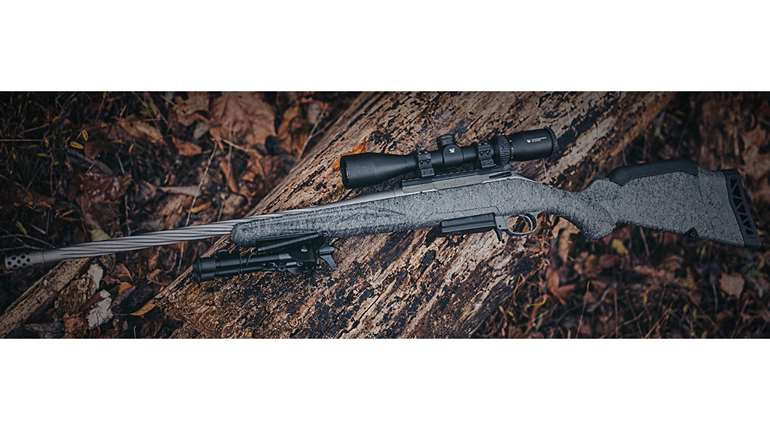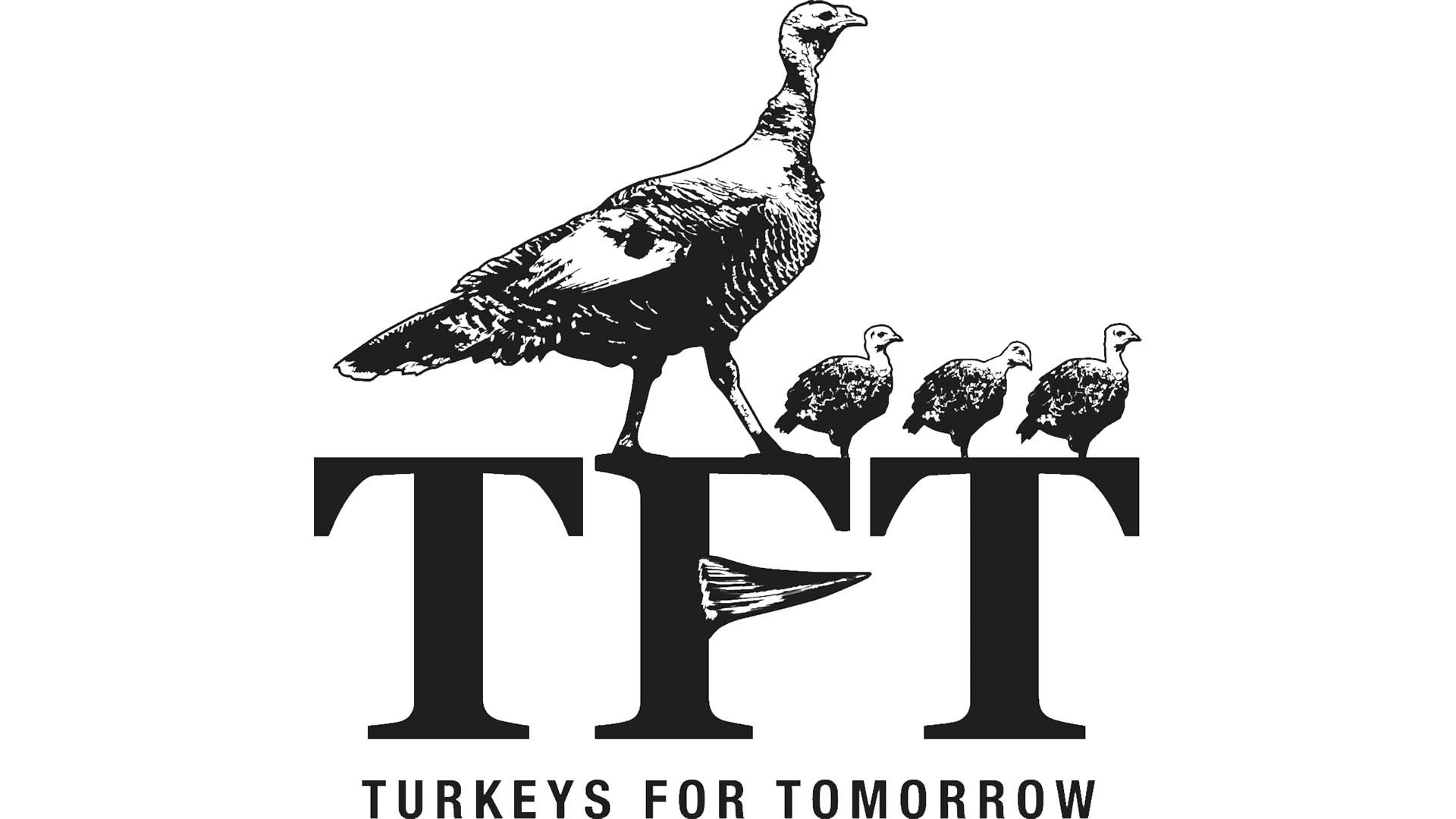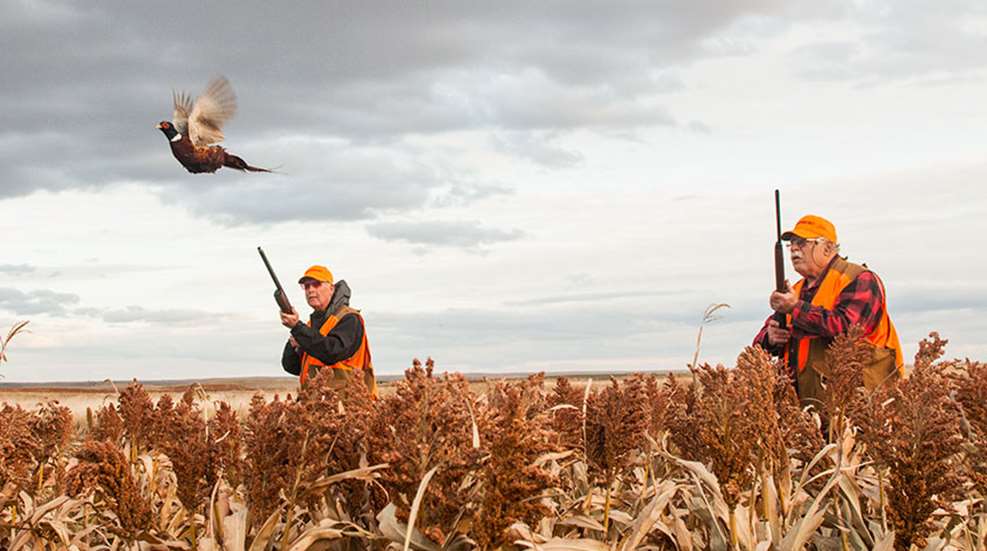
Try it on this drive,” I said. “Just this one time.” I waggled the little 28-gauge semi-auto under my old buddy’s nose. We were pheasant hunting last fall on Scattergun Lodge’s superb preserve east of Pierre, S.D.
“You hunt pheasants with a 12-gauge,” the old curmudgeon, Jim Zumbo, said, waggling his big Mossberg Model 930 Pro-Series Sporting semi-auto right back at me. He’d been using it to knock down nearly every hard-flying rooster our little group had pushed over him. “Besides,” he added, “I’ve never shot a 28-gauge in my life!”
So I happily carried the lithe gun on yet another pass through the deep grass, through a cedar windbreak and into a stand of red milo stalks. That’s where our guide, Eric Ross, announced three important things: “Rooster! Rooster! Rooster!”
It could have gone without saying, given the squawking, flapping explosion of color rising from under the eager nose of big Bear, Scattergun’s Labrador emeritus. The “inadequate” 28-gauge rose in perfect cadence with the first bird, swept past its red cheeks, and popped almost of its own accord, leaving plenty of time to swing left and pick up the trajectory of the second rooster. Pop! As that one plummeted back into the milo, the diminutive gun reached the third ringneck and terminated its flight, too.
Granted, none of this trio was more than 30 yards out, and that’s about optimum range for an improved-cylinder 28-gauge. A few minutes later my Mossberg International SA-28 was tasked with finishing a streaking bird Kansan Dave Zumbaugh had wobbled at the far side of the field. That ringneck had reached cruising speed and was angling for the bottom of one of Scattergun’s many scenic draws when my ¾-ounce load of chilled No. 7½ pellets intercepted it. We paced 45 yards to the feathers where Bear had scooped it off the ground.
Small Successes
These anecdotes don’t mean the 28-gauge is the world’s best pheasant-taking tool, but they do suggest this smallest of our true gauges deserves closer examination.
The first question might be, why? Why did anyone ever dream up a shotgun gauge with a bore diameter of just .55 inch? And when? There is evidence of 28-gauge smoothbores being recognized as far back as 1855. Those would have been muzzleloaders. But even before then, hunters could stuff just about any projectile they wanted down their smoothbore muzzleloading barrels, switching from single bullets to charges of shot as needed. Bore diameters of .50 inch through .70 inch were quite common. It is likely that many hunters were shooting 28-gauges regardless whether they knew it.
Once breechloading cartridge guns came into common use during the 1870s, gauges and shell sizes became standardized. There is some evidence that French and British gunmakers were producing 28-gauges as early as 1875. Remington offered a 28-gauge single-shot in 1893, but Parker put the 28 on the map in the U.S. when it began chambering its side-by-side doubles for the gauge starting around 1900. Winchester kept the ball rolling with a 28-gauge version of the Model 12 pump gun in 1937. Eventually many other U.S. gun makers joined the parade.
Given the population levels of bobwhite quail and pheasants in that era, the mid-20th century must have been heady times for the 28-gauge. Gentlemen hunters could afford to take a risk with a smaller gun because there were so many birds. South Dakota’s daily pheasant limit was once five roosters and two hens. I suspect most new 28-gauge shooters quickly realized, as most of my friends and I have discovered, that they shot as well as, if not better than, they did with their 12- and 16-gauge guns. Credit the 28’s lighter weight, trimmer lines and faster handling characteristics. Successful upland bird shooting is often more about snap-shooting or instinctive shooting than firepower.
That is what I wanted Zumbo to discover for himself at Scattergun Lodge, but he continued to resist until fellow hunter Zumbaugh traded the Mossberg International Silver Reserve over/under 20-gauge he’d been shooting for my SA-28. Dave then proceeded to clean the skies, including one escaping ringneck at a crazy 47 paces. Zumbo finally caved to our ribbing. He blocked our next drives with the “pipsqueak” 28. He didn’t miss a beat. Or a bird. Pheasants rained from the sky the same as they had when he’d swung the 12-gauge. He now claims his favorite upland shotgun is the SA-28. So does Dave. And so do I.
Of course preserve pheasants, even the superbly conditioned, hard-flushing ones at Scattergun, are not as tough as wild birds, so I tested my new semi-auto 28 on our old family farm later in the season. Trust me, those birds were wild. I and other family members have been harassing them with 12-, 16- and 20-gauges every fall for half a century. And what do you think that little 28 did to them? It dropped them like Mike Tyson used to drop heavyweight contenders. Rising birds, crossing birds, incoming, going away … I spun one out of the air from an improbable distance of 55 steps. Subtract 10 yards for the trajectory of the bird’s fall, and you still have a shot any 28-gauge can hang its hat on.
Lest you write me off as Mr. Hyper Hyperbolic, let me assure you I didn’t come to the 28-gauge easily. Like most Dakota farm boys, I was a 12-gauge man for 14 years before adding a 20-gauge to my arsenal. It was another 16 years before Tom Huggler’s proselytizing on behalf of the 28-gauge wore me down. “Maybe it’s magic,” my Michigan friend said, “but it just works. I kill more birds with fewer shots. And I can cover more miles with this light little thing.”
I bought a Ruger Red Label 28-gauge in 1996, and the birds have regretted it ever since. Doves, quail, grouse, chukars. If I remember right, that first season the Ruger put 22 or 23 roosters in the freezer out of 25 engaged. Many of those required more than one shot but none more than two, and more of them fell to the first barrel than the second.
Since then I’ve enjoyed impressive 28-gauge performance with an over/under and a side-by-side from CZ. A few years ago I tried a new Benelli Ultra Light semi-auto on the trap range, went 12 for 12 and quit before I talked myself into buying it. Pretty crazy when you can pick up any gun for the first time and bust 12 clays in a row. It’s testament to good gun fit and the easy-shooting 28-gauge.
Fast forward to last fall. Zumbo is standing at the end of yet another Scattergun milo strip. Only this time there’s a narrow-barreled gun in his hands. We drive a wild rooster toward him. It hits terminal velocity and is approaching orbit as it passes more than 40 yards to the right of my old buddy. Zumbo calmly pushes up the “toy” 28-gauge, and pop, the rooster crumples. And then he does it again and again for the rest of the day, after which we have to pry his fingers off that gun.
I emphasize my friends’ exploits with the 28-gauge lest I drone on about my own successes. I couldn’t blame anyone for calling me a liar or braggart. So I’ll brag on others as a leavening agent. The point is this: It’s not the shooter. It’s the gun and the gauge, together, because alone neither is all that impressive.
When Less Is More
You may have heard the 28-gauge shell patterns uniformly because it contains a “square” payload. That’s supposed to mean its stack of pellets is as tall as wide, suggesting the pellets slip down the .55-inch bore more efficiently with less mangling than they would if stacked tall and deep. But that isn’t true. A ¾-ounce charge of shot in a 28-gauge hull is about twice as high as wide. Perhaps if modern shells were packing the ⅝-ounce payloads of earlier 28-gauge shells, the pellet stacks would come close to square, but they probably don’t need to. Modern shot cups protect pellets from bore scrubbing. Hardened, copper-plated shot resists inertial deformation, and a 28-gauge payload doesn’t weigh that much anyway.
This raises the issues of pellet diameter vs. bore diameter and total pellet count. As any two people who have tried to simultaneously squeeze through a narrow door know, wide loads can jam in tight openings. And a .55-inch tunnel is tight. Larger shot sizes are not going to flow neatly through a 28-gauge barrel. You may find the odd 28-gauge shell stuffed with No. 4 or even No. 2 shot, but No. 6 is usually the largest size most ammunition manufacturers offer. While No. 6 patterns fairly consistently, No. 7½ beats it and No. 8 improves on that. Quite common are No. 9 loads, but they are bought mainly by skeet shooters who only have to chip a clay bird to score. Quail and doves will fall to No. 8 shot, but those tiny pellets become a bit anemic beyond about 25 yards to cleanly take larger birds.
Most upland gunners will shoot loads having No. 6 or No. 7½ pellets. The typical ¾-ounce load will hold 169 or 262 of these, respectively. (Compare that to a 1¼-ounce 12-gauge load, which will have 282 or 440.) Recent experiences with No. 7½loads have convinced me they are all I need for upland birds, including ringnecks and sage grouse. When ducks and geese are decoying close, I’ve been known to shoot a ⅞-ounce load of No. 6 Kent Bismuth. I try for head shots, and it works surprisingly well. The load is even sufficient for body shots inside 25 yards.
But let’s be brutally honest here. There is no inherent advantage to the 28-gauge shell or bore diameter. The 12-gauge is far and away more effective. Ditto the 16 and 20. So the question hangs there: Why do so many upland hunters love the 28-gauge?
It’s the guns. Gotta be. The combination of trim, light and quick-handling qualities with no flinch-inducing recoil makes a well-designed 28 eminently forgettable. And that’s what a shotgun should be. You should forget you’re even operating it. It should become an extension of your vision. You should use it as naturally and instinctively as throwing a ball. The bird gets up, you lock laser focus on it, the gun rises to your face, and you shoot without so much as thinking about the gun.
This makes you cousin to the falcon, brother to the bobcat. Natural predators don’t think about their legs, wings, talons. They just focus on their prey and strike. That seems to be what 28-gauge aficionados do. Maybe you should, too.
28-Gauge Pros
• Lightweight: Most 28-gauge shotguns come in at 5.5-6 pounds, nice for long hikes across pheasant prairies and up chukar canyons.
• Trim and easy to swing: A well-built 28 should balance between your hands but be just a bit muzzle-heavy to help stay on track during crossing shots.
• Low recoil: No slap in the face, no jolt at the shoulder to inspire flinching.
• Low report: Your ears shouldn’t ring if you forget hearing protection.
• Lighter shells: On some Idaho backcountry hunts I’ll climb 2,000 feet, hike 8 miles and shoot a mixed bag of grouse, quail, chukars and huns, easily burning through 25 rounds. In 12-gauge, those shells take up a lot of pocket space. In 28-gauge, not so much.
28-Gauge Cons
• More expensive shells: High-volume sales keep 12-gauge prices low. Even though 28-gauge loads use less powder and shot, they cost twice as much. Serious shooters reload hulls to save money.
• Limited shot size selection: It’s difficult to find loads with shot larger than No. 6.
• Few non-lead loads: Limited options include Kent Bismuth No. 6, Federal Field & Range Steel Game & Target No. 6 and 7, and Winchester Super-X Xpert High-Velocity Steel No. 6 and 7.
• Poor choice for waterfowling: Smaller pellets reduce effective range for ducks and geese; see two previous points.













